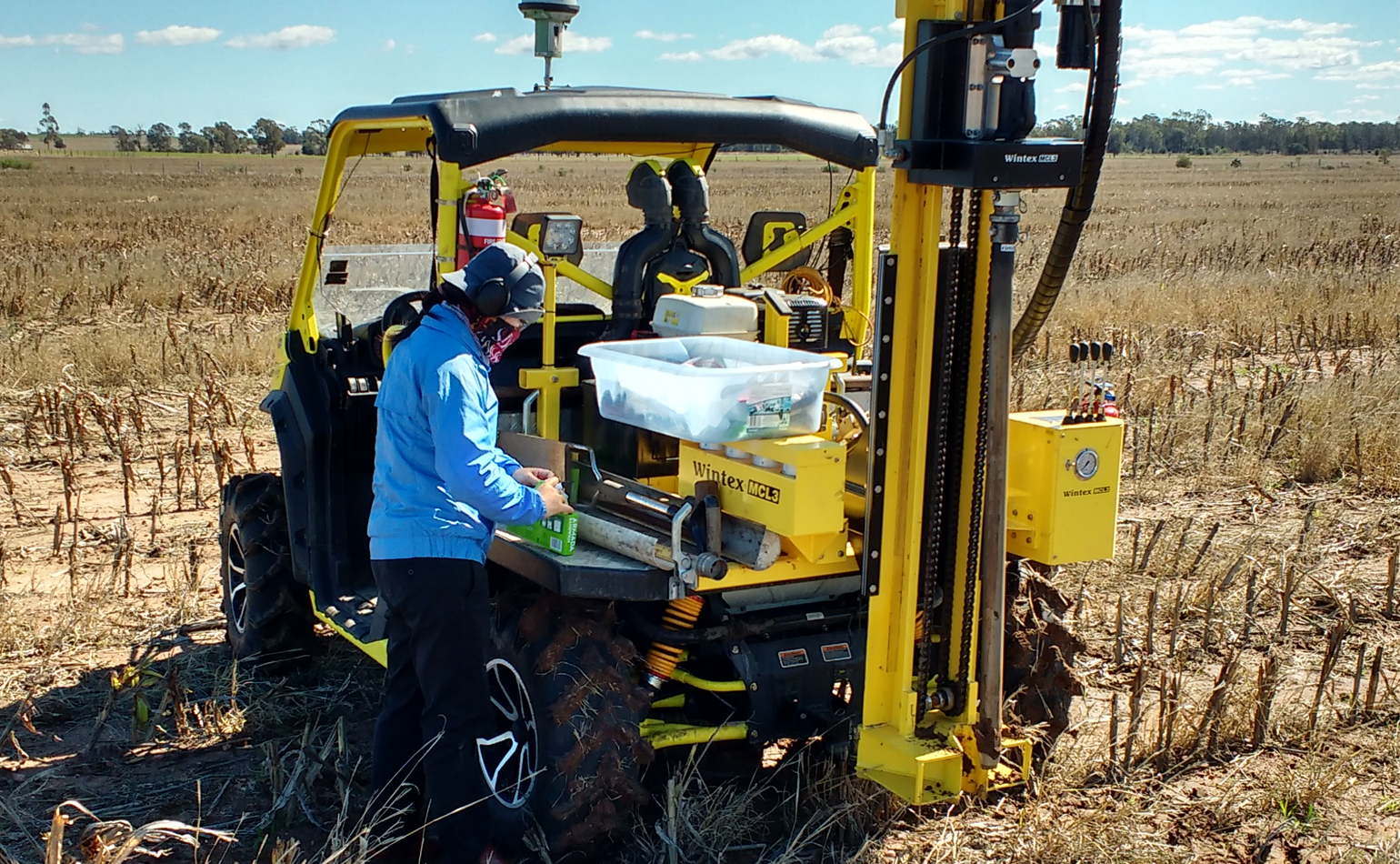Postdoctoral Research Fellow Yingcan Zhu at the Millmerran trial site collecting calibration samples.
Project: New sensors to measure soil nutrients
Project Leader: Dr Craig Lobsey University of Southern Queensland
This project is developing novel technology to directly measure soil chemical status, soil hydraulic characteristics and water retention influencing nutrient movement in a cost-effective way.
The long-term objective is to develop a data-model driven platform that supports farmers to site-specifically manage their soil for optimal productivity and long-term sustainability.
The issues
Soil is highly variable and dynamic, not just across the field but also through depth. Soil health and performance are directly related to the interactions between the physical, chemical, and biological elements of the soil. Detailed information on the status of these elements, through depth and across the field, is required by farmers for good soil management.
It is vital to understand how these soil components interact (at any given location) to sustain soil function and support plant growth. This can be achieved through the fusion of several sensor technologies, leveraging their unique abilities to provide timely, spatially detailed, or specific information routinely and cost effectively.
Novel application of existing sensor technology and spatiotemporal mapping techniques can be used to extrapolate this information across the field and through time.
Soil chemical sensing – nutrients, sodium and pH
There have been few technologies that viably directly measure soil chemical status as soil is a challenging and complex medium (e.g., due to buffering). Electrochemical sensors have previously been demonstrated as viable and more recently several developments, such as screen-printed electrodes (SPEs) promise to support more cost effective and robust sensors for field application. This project has been successful in fabricating low-cost sensors for sodium measurement through modification of commercially available SPEs (DropSens) with promising results. Laboratory evaluation of low-cost sensors for phosphate are on-going.
The grower groups involved in this project – Burdekin Productivity Services (BPS) and Herbert Cane Productivity Services (HCPS) collected and freighted numerous soil samples from their regions to the University of Southern Queensland laboratories. These samples have been scanned using visible-near infrared spectrometer, which the project is evaluating to support the estimation of Phosphorus Buffering Index (PBI) using a data-fusion approach.
Repetitive electromagnetic induction (EMI) sensing
The project team are developing and evaluating the novel application of existing EMI sensors that are currently used by farmers and their advisors. These sensors measure soil conductivity through depth. They propose that through repetitive deployment of these sensors, they can apply algorithms to extract the static and dynamic components of these signals that better reflect soil structure and hydraulic characteristics. This will in future be made feasible through recent emergence of agricultural robotics. This information can then be used to enable high resolution mapping of soil chemical status and hydraulic characteristics while also providing more timely and spatially detailed information to the farmer on soil water status (e.g., for irrigation management).
The project team has identified a suitable trial site at Millmerran, Queensland. They have instrumented this site with stationary soil moisture probes at strategic locations and completed a series of EMI and gamma radiometric surveys over several months and rainfall events. Simultaneous data collection is taking place in at a trial site in New Zealand through Landcare Research. They are now at the stage of data processing and algorithm development and evaluation.
Sensing soil hydraulic characteristics
Members of the research team are developing new techniques and automation for high throughput and low-cost analysis of soil water retention, a notoriously lengthy and labour-intensive laboratory process. They have completed a review of sensor technologies and approaches that may be adapted to high throughput and automated analysis.
The most promising approach identified was gamma-ray attenuation that can be used to non-invasively measure soil water content at multiple positions in a soil core. Measurements performed as a soil sample undergoing evaporative drying can be used with inverse parameter optimisation to infer soil water retention parameters. Within an automated system, many samples may be analysed simultaneously providing high sample throughput at lost cost. They have identified a suitable industrial gauge (gamma-ray attenuation) and are currently working through the necessary Queensland Government Health approval processes to acquire this instrumentation.
Project Participants
University of Southern Queensland
Burdekin Productivity Services
Herbert Cane Productivity Services
Manaaki Whenua Landcare Research

